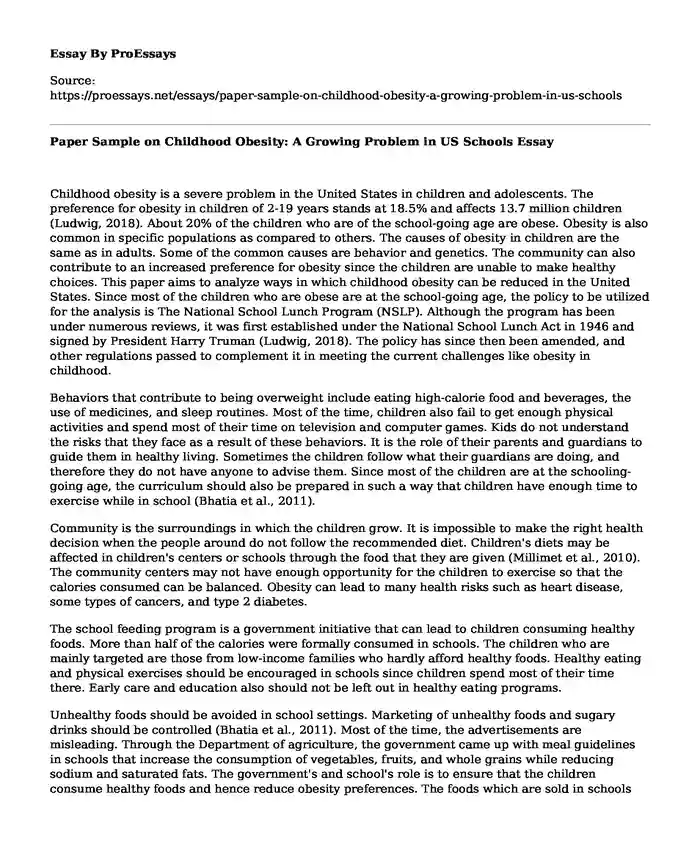Childhood obesity is a severe problem in the United States in children and adolescents. The preference for obesity in children of 2-19 years stands at 18.5% and affects 13.7 million children (Ludwig, 2018). About 20% of the children who are of the school-going age are obese. Obesity is also common in specific populations as compared to others. The causes of obesity in children are the same as in adults. Some of the common causes are behavior and genetics. The community can also contribute to an increased preference for obesity since the children are unable to make healthy choices. This paper aims to analyze ways in which childhood obesity can be reduced in the United States. Since most of the children who are obese are at the school-going age, the policy to be utilized for the analysis is The National School Lunch Program (NSLP). Although the program has been under numerous reviews, it was first established under the National School Lunch Act in 1946 and signed by President Harry Truman (Ludwig, 2018). The policy has since then been amended, and other regulations passed to complement it in meeting the current challenges like obesity in childhood.
Behaviors that contribute to being overweight include eating high-calorie food and beverages, the use of medicines, and sleep routines. Most of the time, children also fail to get enough physical activities and spend most of their time on television and computer games. Kids do not understand the risks that they face as a result of these behaviors. It is the role of their parents and guardians to guide them in healthy living. Sometimes the children follow what their guardians are doing, and therefore they do not have anyone to advise them. Since most of the children are at the schooling-going age, the curriculum should also be prepared in such a way that children have enough time to exercise while in school (Bhatia et al., 2011).
Community is the surroundings in which the children grow. It is impossible to make the right health decision when the people around do not follow the recommended diet. Children's diets may be affected in children's centers or schools through the food that they are given (Millimet et al., 2010). The community centers may not have enough opportunity for the children to exercise so that the calories consumed can be balanced. Obesity can lead to many health risks such as heart disease, some types of cancers, and type 2 diabetes.
The school feeding program is a government initiative that can lead to children consuming healthy foods. More than half of the calories were formally consumed in schools. The children who are mainly targeted are those from low-income families who hardly afford healthy foods. Healthy eating and physical exercises should be encouraged in schools since children spend most of their time there. Early care and education also should not be left out in healthy eating programs.
Unhealthy foods should be avoided in school settings. Marketing of unhealthy foods and sugary drinks should be controlled (Bhatia et al., 2011). Most of the time, the advertisements are misleading. Through the Department of agriculture, the government came up with meal guidelines in schools that increase the consumption of vegetables, fruits, and whole grains while reducing sodium and saturated fats. The government's and school's role is to ensure that the children consume healthy foods and hence reduce obesity preferences. The foods which are sold in schools outside the meal programs are supposed to be healthy snacks.
Having healthy children is crucial to the progress of the country. Healthcare is critical to the government, and it cannot be ignored. The state cannot develop when the citizens are still facing health challenges. Most of the children who have obesity when they are young are five times more likely to have it even in adulthood (Ward et al., 2017). Adults with obesity are more likely to get some health conditions like diabetes and hypertension. The NSLP operates in public schools, private schools, nonprofit schools, and residential care institutions. It is a suitable way to encourage more children to eat healthily and hence avoid being obese.
References
Bhatia, R., Jones, P., & Reicker, Z. (2011). Competitive foods, discrimination, and participation in the National School Lunch Program. American Journal of Public Health, 101(8), 1380-1386. https://ajph.aphapublications.org/doi/full/10.2105/AJPH.2011.300134
Ludwig, D. S. (2018). Epidemic childhood obesity: Not yet the end of the beginning. Pediatrics, 141(3). https://pediatrics.aappublications.org/content/141/3/e20174078.abstract
Millimet, D. L., Tchernis, R., & Husain, M. (2010). School nutrition programs and the incidence of childhood obesity. Journal of Human Resources, 45(3), 640-654. http://jhr.uwpress.org/content/45/3/640.short
Ward, Z. J., Long, M. W., Resch, S. C., Giles, C. M., Cradock, A. L., & Gortmaker, S. L. (2017). Simulation of growth trajectories of childhood obesity into adulthood. N Engl J Med, 377, 2145-2153. https://www.nejm.org/doi/full/10.1056/NEJMoa1703860
Cite this page
Paper Sample on Childhood Obesity: A Growing Problem in US Schools. (2023, Dec 01). Retrieved from https://proessays.net/essays/paper-sample-on-childhood-obesity-a-growing-problem-in-us-schools
If you are the original author of this essay and no longer wish to have it published on the ProEssays website, please click below to request its removal:
- Teaching Methods Essay Example
- Post-Colonial Theory: The Individual and the Nation in Ngugi Essay
- Essay Sample on Gaining Confidence in Teaching the Deaf and Hard Hearing
- Article Analysis Essay on "The Longest War"
- Essay Example on Women's Suffrage Movement: 1848 - Fight for the Right to Vote
- From Homeless to Harvard: Liz Murray's Journey to Success - Essay Sample
- Essay Example on Residential Treatment Centers (RTCs): Evolution of Care for the Mentally Ill







